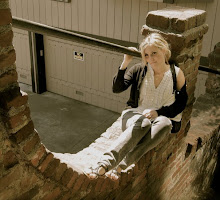
On our second full day in Vienna, Jason and I were off to the “let’s show off our wealth” grandeur of Schönbrunn Palace—the Hapsburgs former summer residence. While enjoying the excessively gilded rooms, we took note of the pouring rain outside. Of course it wasn’t raining when we left our hostel—meaning my umbrella was still soundly secured in the front section of my backpack. Unfortunately, the incredible expanse of grounds, fountains, and Baroque villa at the far end of the garden are all part of what makes this palace famous. Thus we had two options: make a run for the underground station—limiting our memory of the beautiful gardens to guidebook pictures, OR purchase an umbrella and traverse those wet pebbled paths. Now when will Jason and I ever be back in Vienna? My point exactly; we chose the latter. One royal blue umbrella purchase later, we were outside—two troopers tiptoeing around growing puddles to become lone (and freezing) tourists amidst several square miles of yellow trees, perfectly-groomed grass, and flower beds.
After our wet morning jaunt, Jason and I deserved a break. What better way to spend it at Café Central—one of the city’s best-known cafes and where Vienna’s intellectuals met at the turn of the 19th century? Done ☺. I mean even Leon Trotsky, exiled to Vienna, plotted the 1917 Russian Revolution here. Jason and I (on the other hand) unsuccessfully plotted how we could not spend more than twenty euros on coffee and pastries. The café, which is actually inside of the Ferstel Palace, was quite grand, the food and drinks quite good, and Jason and I quite satisfied despite the expense.
After the nourishing respite, we proceeded to Karlskirche, a Baroque masterpiece of a cathedral with two gigantic marble columns on the side, and a colossal seagreen dome in the center. Jason settled for guidebook pictures of the inside this time, due to a six Euro entrance fee (I had been able to view the inside two years ago). Located just beyond Karlskirche was Vienna’s Liberation Monument. As we approached its high pillar with a large golden-helmeted soldier on top, we noticed the large Russian characters that engrained the colonnade behind the pillar. I said to Jason that maybe it was made by the Viennese people for the Russians to thank them for liberating their city from the Germans at the end of WWII. Well, I at least had my time period right. Our guidebook explained that when the Russians occupied Vienna after the war (the city was sectioned like Berlin among the allied victors), they built a monument to themselves, their success in defeating Hitler, and in commemorating the Russians who lost their lives. When ownership of Vienna was returned to Austria in 1955, the Russians mandated the monuments permanence. And hence the reason, we saw it today; because Vienna had to keep it—whether or not they wanted to is a different story.
The Belvedere Palace was next on the agenda, and I had to find the perfect entrance: start at the lower Bevledere grounds and walk up to one of the most prized gems of Vienna: the Upper Belvedere. These two palaces together compose one of “the most ambitious building projects ever undertaken by a private individual”—this private individual was Prince Eugen of Savoy, famous for his defeat of the Turks in 1683. Don’t worry; I had to research the above information—obviously my Austro-Hungarian Empire history needs a little polishing lol. (I don’t plan on doing that ‘polishing’ anytime soon either). The upper palace now houses some of the most famous pieces by famed Secessionist artists such as Gustav Klimt, Egon Schiele, and Oskar Kokoschka. I was most excited to show Jason Gustav Klimt’s The Kiss (one of my favorite paintings). Although all of the grand fountains leading up to the main entrance were turned off and drained for the approaching winter season, the view remained phenomenal, and well, the artistic mastery of all the paintings inside spoke for themselves.
After the Belvedere, a quick walk by Vienna’s Spittelberg section (cobblestone streets and handicraft stores), the Museum Quartier, and the Volkstheater (known as the “People’s Theater” and established as a counterpart to the imperial Burgtheater), landed us at a high-end tavern called the Einstein for dinner. Do to the combined breakfast-lunch around 11am, we were starving by five, and both gave in to the cholesterol-increasing menu items that make Vienna’s cuisine famous. Jason’s Berner Würstel (two large sausages wrapped in bacon with French fries) and my Wiener Schnitzel (although I got turkey instead of pork cutlets) with potato salad definitely made up for our lack of distinctive meals earlier.
In all, Vienna truly was a blur of excitement. With the first snowfall, even the city itself was on the move. Everywhere we went, we were constantly reminded of the Christmas season to come, as workers around the city set up wooden stalls for the famous Kristkindelmarkts, strung lights, or hauled in Christmas trees. Although Jason and I saw, toured, and photographed the important sights, the traditional Christmas displays—simply part of German and Austrian culture—reminded me of a different type of trip I hope to take one day, and a place to where I must return.
Onwards to Prague!

No comments:
Post a Comment